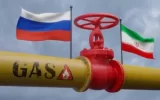Russian gas transmission to Iran via Azerbaijan: from idea to reality

According to an exclusive report by Energy Press, during the visit of Iranian President Masoud Pezzekian to Moscow, the Russian side unexpectedly announced that the partners of the strategic contract had reached an agreement to transport a large volume of Russian gas to Iran via the Republic of Azerbaijan. The volume of these exports will be 55 billion cubic meters per year. According to some experts, the new agreement to import Russian gas through Azerbaijan may reflect the problems in the construction of the pipeline under the Caspian Sea.
Moscow-Tehran Gas Cooperation: An Alternative to Western Hegemony
Russian President Vladimir Putin said at a press conference after talks with Pezzekian that the construction of a gas pipeline from Russia to Iran is underway. Putin added: “The North-South Corridor and the gas pipeline to Iran are two ongoing projects that are both very important and attractive.” This comes as Russia is trying to diversify its energy markets after gas imports from the European Union decreased as a result of the ongoing conflict in Ukraine. Delivering gas to Iran could strengthen bilateral ties with a broad and growing arms and security dimension. But there are many obstacles to overcome.
Iran’s natural gas production has experienced fluctuating trends in recent years. Production rose from 262.3 billion cubic meters in December 2022 to 275 billion cubic meters in December 2023. However, Iran has seen a slight decline in production over the past five years, with an annual growth rate of minus 0.03 percent. However, the future outlook for Iran’s gas production is more optimistic, with forecasts indicating 3 percent growth from 2024 to 2028.
According to energy researcher Barbara Salvin, this difference between historical performance and future expectations highlights the challenges facing Iran’s natural gas sector, including insufficient investment, technological constraints, and the impact of international sanctions. However, if Iran addresses these obstacles and leverages its vast reserves, along with planned investments in exploration and production activities, the projected growth shows potential for improvement. The Iran-Russia memorandum of understanding reflects their growing geopolitical alignment. Moscow and Tehran want to challenge the West’s hegemony in energy markets by cooperating in platforms such as BRICS and the Shanghai Cooperation Organization (SCO) to create alternative energy corridors.
Challenges Ahead
The Russia-Iran gas deal has the potential to change the dynamics of energy trade by creating new routes and strengthening connections between countries with abundant energy resources. However, experts say Iran’s determination to become a regional gas hub does not seem very logical given its reliance on imported gas to meet domestic needs. Uncertainty is heightened by rising geopolitical tensions, infrastructure weaknesses, and potential additional sanctions that are likely if the new Trump administration applies maximum pressure on Iran.
Tags:gas
- Comments sent by you will be published after approval by site administrators.
- Comments that contain slander will not be published.
- Comments that are not in Persian or not related to the news will not be published.

Comments
Total comments : 0 Awaiting review : 0 Date: 0